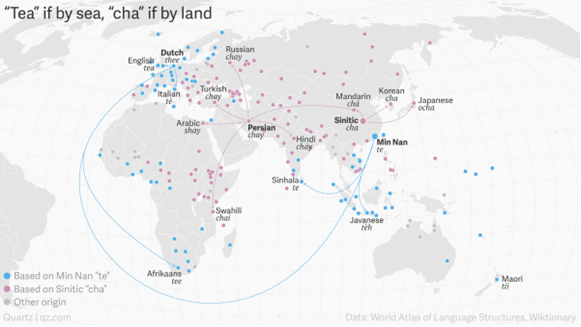[解析]
(1)D.细节理解题。根据第二段的Both forms come from China.How they spread around the world offers a clear picture of how globalization worked.(这两种形式都来自中国。它们在世界各地的传播方式,为全球化如何运作提供了一幅清晰的画面)可知,"cha"这个版本的传播是全球化的一个例子。故选D。
(2)C.细节理解题。根据倒数第二段的The "té" form used in coastal Chinese primary languages spread to Europe via the Dutch,who become the primary traders for tea between Europe and Asia in the 17 century.(沿海汉语中使用的"K式通过荷兰人传到欧洲,荷兰人成为17世纪欧亚之间主要的茶叶商人)可知,"te"的形式是荷兰人传到欧洲的。故选C。
(3)A.推理判断题。根据第一段的One is like the English term──té in Spanish and tee in Afrikaans are two examples.The other is some variation of cha,like chay in Hindi.(其中一个类似于西班牙语中的英语术语"te",南非荷兰语中的"te"就是两个例子。另一个是cha的一些变体,比如印地语中的chay),第三段的 The term cha is Sinitic(汉语语系),meaning it is common to many varieties of Chinese.It began in China and made its way through central Asia,eventually becoming "chay" Persian(cha这个词是中国的,意思是它在中国的许多种类中都很常见。它起源于中国,穿过中亚,最终成为波斯语中的"chay")和倒数第二段的"The "té" form used in coastal Chinese primary languages spread to Europe via the Dutch,who become the primary traders for tea between Europe and Asia in the 17 century.(沿海汉语中使用的"te"形式通过荷兰人传到欧洲,荷兰人成为17世纪欧亚之间主要的茶叶商人)可知,本文是通过举例来展开的,故选A。
(4)C.文章出处题。通读全文,尤其是第一段的With a few minor exceptions,there are really only two ways to say "tea" in the world.One is like the English term──té in Spanish and tee in Afrikaans are two examples.The other is some variation of cha,like chay in Hindi.(除了少数少数的例外,世界上真的只有两种表达"茶"的方式。一个是像英语tem﹣te在西班牙语和tee在南非荷兰语是两个例子。另一种是cha的变体,比如印地语中的chay)"可知,本文主要讲的是"茶"这个字在不同的国家的不同叫法,因此推知该文最有可能来源于杂志,故选C。

